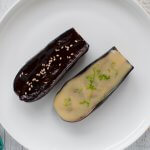
Pan-fried eggplant topped with sweet miso sauce is a very simple side dish or appetiser. Sweet miso goes so well with eggplant, which melts in your mouth. The secret to my miso sauce is the egg yolk. It gives a better texture to the miso sauce and the flavour is rich but delicate. Each miso type makes about 6 tablespoons of dengaku miso. Pick any type of miso and follow the instructions. Serving is based on the amount of eggplant used in the recipe.
Cook time assumes 1 kind of miso sauce is made.
- 80 g aka miso (note 1)
- 1 egg yolk , remove chalazae ( little white strings)
- 2 tbsp sugar (note 2)
- 1 tbsp sake
- 1 tbsp mirin
- 80 g sweet shiro miso (note 1)
- 1 egg yolk , remove chalazae ( little white strings)
- 1 tbsp sugar (note 2)
- 2 tbsp sake
- ½ tbsp mirin
- 80 g awase miso (note 1)
- 1 egg yolk , remove chalazae ( little white strings)
- 1½ tbsp sugar (note 2)
- 1 tbsp sake
- 1½ tbsp mirin
- 200-250 g eggplant (1 large or 2 small, note 3)
- 2 tbsp+ oil
- Roasted white sesame seeds
- Grated lime rind
-
Add miso and egg yolk in a small saucepan and mix well using a spatula.
-
Add the remaining Dengaku Miso ingredients of your choice and mix well.
-
Place the saucepan over medium heat and constantly mix the miso sauce using a spatula.
-
When the edge of the miso sauce starts bubbling, reduce the heat to the lowest setting and continue to cook and mix for about 2 minutes until the sauce thickens to the consistency of mayonnaise.
-
Turn the heat off and transfer to a bowl or an air tight container. When slightly cooled down, cover with cling wrap/lid and store until required.
-
The amount of one type of dengaku miso can serve 8-10 pieces of eggplant (note 4).
-
Remove the stem end of the eggplant.
-
If you are using one large eggplant, cut it crosswise into 2cm wide discs. There should be about 6 discs. Do not use the round end of the eggplant. If using two small eggplants, cut each of them vertically into half.
-
While working on each piece of eggplant, keep the rest in a bowl filled with water. This will prevent the flesh of the eggplant from getting brownish.
-
Score the eggplant flesh at 1cm intervals as far as you can without cutting through to the other side. Then score again perpendicular to the first cuts (if discs) or to make diamonds (if vertically cut eggplants).
-
Run a knife around the eggplant shape, just inside of skin.
-
Add the eggplant pieces and the oil in a bowl and thoroughly coat them with the oil.
-
Heat a non-stick frypan over medium heat. Hold the eggplant pieces in a bowl and drain the oil into the frypan if any oil is accumulated at the bottom of the bowl.
-
Place the eggplant pieces in the pan, scored side down and cook for 2 minutes.
-
Turn them over and cook further 2 minutes. The eggplant flesh should become quite soft but if the thick part of the eggplant is not soft yet, place a lid on and cook further 30 seconds to 1 minute.
-
Turn eggplant pieces over and transfer them onto a serving plate.
-
Drop ⅓ or ½ tablespoon (note 4) of dengaku miso on each piece of eggplant and spread the miso over the entire surface of the eggplant.
-
For dark miso, sprinkle white sesame seeds over the top (if using). Grate lime rind (or sprinkle dried seaweed flakes) over white miso.
-
Serve while warm.
1. There are mainly three types of miso that have noticeably different colours. Aka miso is very dark brown and almost reddish. It is also called ‘hatchō miso’ or ‘akadashi miso’.
Sweet shiro miso has a very light brown, almost yellowish colour. This is the sweetest miso. It is also called ‘Saikyo miso’. Don't get confused with brownish miso labelled 'shiro miso' that you can buy at supermarkets. It is not sweet shiro miso. It's as salty as awase miso.
Awase miso is brown and there are so many variations of this kind. The saltiness of this miso is between aka miso and shiro miso but the degree of saltiness varies depending on the brand and the type of miso.
I made all three kinds of dengaku miso in this recipe but you don’t need to do that unless you already have these types of miso in the fridge.
2. My dengaku miso is probably not very sweet. If you have a sweet tooth, you can adjust the sweetness by adding extra sugar.
3. I made two batches of nasu dengaku using different sized eggplants. The first batch was from a large eggplant that weighed 230g. I cut it into discs. The second batch was from two smaller eggplants that weighed about 250g. They were cut vertically in half.
4. The amount of dengaku miso required to cover the surface of the eggplant varies depending on the size and shape of the eggplant pieces. The dengaku miso is quite thick and dense with strong miso and sugar flavours. Do not over use it.
5. Dengaku miso in an air tight container keeps up to 2 months in the fridge.